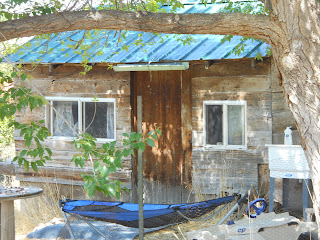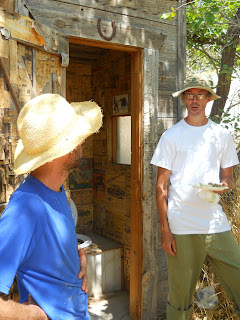Hippies, real hippies, with long, uncombed hair, straggly beards, no shoes. Even though I pretend to be a hippie, I wasn't sure I wanted to be there. I sort of identify with the lifestyle, the politics, but in my mind, they're a little too unreal for me. Generally, I just don't like collective identities--from redneck to beats to flower children to Mormons (and I'm one of them) to new-agers to punks. People scare me when they swarm together. Even artists, writers, poets. Yet, as I moved up the straw-bail bordered dirt path, a weird thing happened: I seemed to have entered a Monte Python collage or Sgt. Peppers album cover. For although a portion of the gathering were clearly latter-day hippies, others, especially the kids, seemed to be right out of a scene from Little House on the Prairie--beautiful girls in home-made Pioneer dresses, wearing no shoes, running the prairie hillside. The house too could have been right out of Little House. But there were also typical ranchers, as well as teens with concert t-shirts.
Although I can't pretend that I immediately fit right in (I never do), this strange mixture of peoples soon put me at ease--especially Adam's dad, the familiar Utah farmer who gave me a tour of the property.
I won't post here how to build an adobe oven. A web search provides multiple sites for that. Instead, I want to share a photo essay of the close community I felt, something akin to the feeling invoked by the barn-raising scene in Witness. Although I can't say for certain what was so spiritually empowering about this event, I think I've identified two strong ingredients: 1) It truly was multicultural--Jews, hippies, Mormons, home-schooled children, jock-teens and red-neck farmers all together in one place, and 2) work, rather than ideas or politics, focused us.
Perhaps what was most beautiful was that no one had to melt his/her identity away to fit into the kettle.
I hope my photos capture a little bit of the joy of different cultures coming together to build something as simple as a bread oven. In order to maintain the privacy and integrity of this community, I used the name of the farm, but ommitted the town name. Enjoy.
1. The site: Located about 10 miles from Dry Creek, Cedar Springs is a working permaculture farm which hosts interns.
2. Adam's cabin at Cedar Springs, which his dad built from refurbished wood and windows.
2. Finishing the sand mold, which is later removed, once the adobe dries.
3. Mixing the adobe--about 1 part sand; 2 parts clay, but varies depending on clay source.
4. Adding newspaper to the mold allows the adobe to stick. Burns off once the sand mold is removed and the oven is used.
5. An evaporating refrigerator that uses two small watering troughs and burlap panels. It works like a swamp cooler. Throughout the day, it was 10-15 degrees Fahrenheit cooler inside the fridge than outside.
6 & 7. Applying the first coat of adobe.
8. Texturing the first layer of adobe with thumb-holes so that the second layer will stick.
9. First coat of adobe dries before applying the second coat.
10. Tour after lunch: Intern lodge--a converted old chicken coup.
11 & 12. Interior of intern lodge.
13. Composting toilet seminar.
14. Touring the grounds.
15. Applying the wet glue (thinned clay-sand mixture) before attaching the second coat of adobe.
I truly believe we could heal this country through barn-raisings: whether the "barns" be adobe ovens, libraries, bowling allies, refurbished parks or community theaters. It's not the projects that matter, but rather bringing people together and keeping them so busy working on a common goal they forget the stereotypes and see the beauty of the people behind the various costumes.
Obviously at some point, ideas, beliefs, differences must be shared. But too often in our society, we stake out our position before we really even know the opposition. I believe something as simple as a community barn-raising by members of congress before each legislative session could forever change the nature of political dialogue in our country.




















What a wonderful post. Thanks so much for putting that into words. It was wonderful experience.
ReplyDeleteYou're welcome. It was wonderful.
Delete